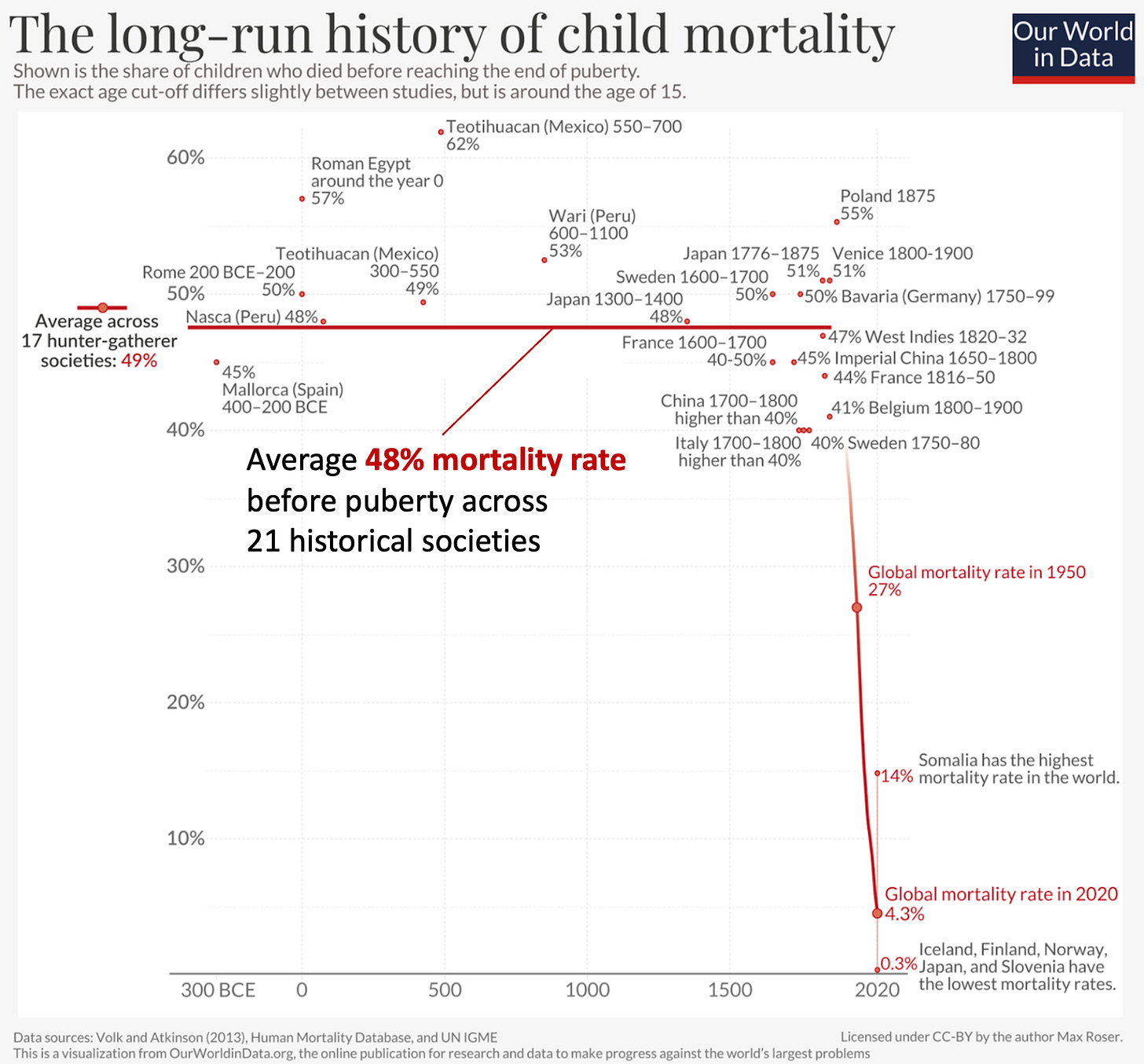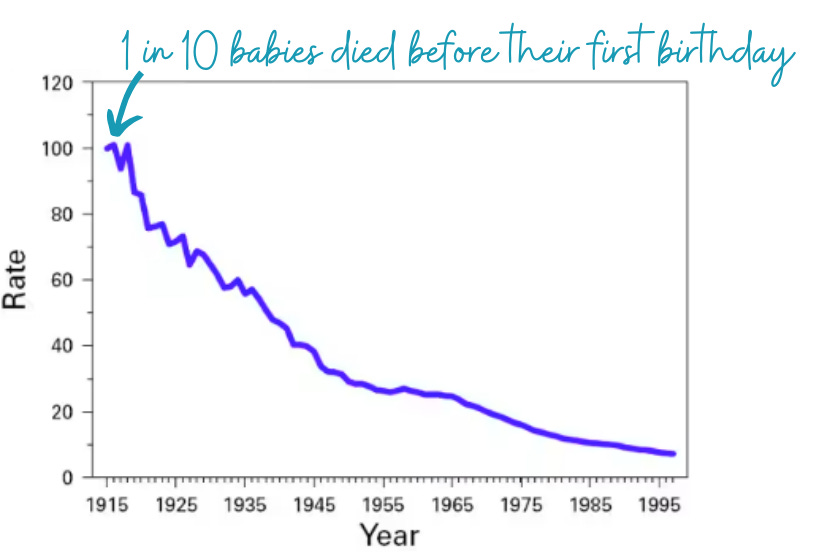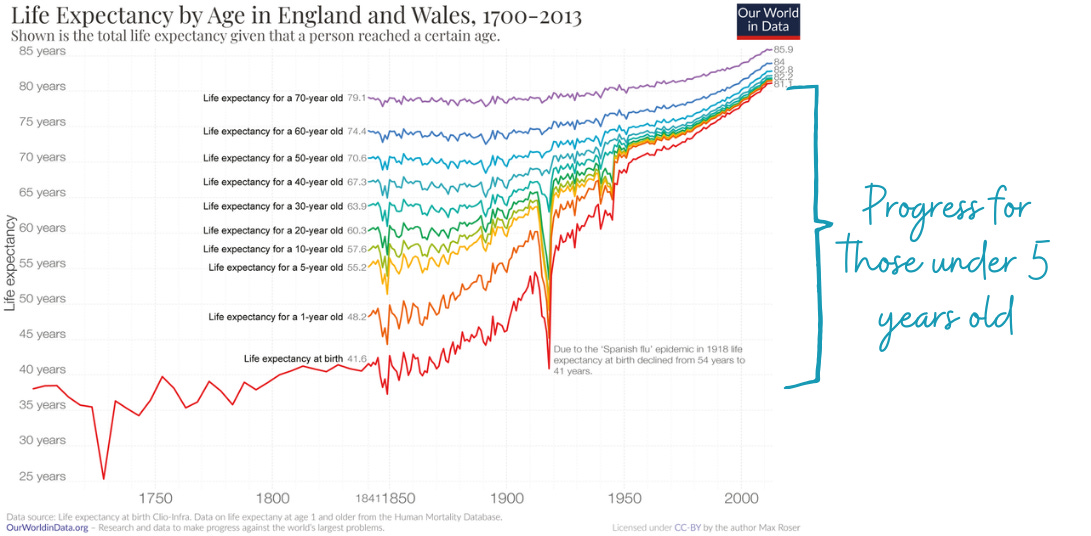Kids don't need to get sick to be healthy
We have forgotten how many children used to die before their fifth birthday
In response to rising measles cases this year, some are claiming that measles is actually good for children—that fighting off the infection will make them stronger.
These rumors are catalyzed by the overall sentiment that children in our modern era are less healthy than they used to be. While there are some types of disease where this is true—metabolic syndrome is on the rise, for example—infectious disease is certainly not one of them.
Infections are not good for children—they have historically been the top killer of children—and our modern age is an anomaly, in a good way, when it comes to the ultimate marker of childhood health: not dying.
The mythical “good old days”—when children had flourishing immune systems from their natural lifestyles and didn’t need antibiotics or vaccines—simply did not exist. Back in those days, a lot of children died.
We have forgotten how many children used to die before their fifth birthday.
Today, the death of a child is considered unusual and especially tragic. For nearly all of history, this wasn’t the case. Death of children was extremely common. Until about the 1800s, roughly half of children died before reaching puberty.

In the early 1900s in the U.S., one in ten infants would not make it to their first birthday, and 30% of all deaths in the U.S. were children younger than 5 years old, compared to less than 1% today.

For most of history, infections were the top cause of death
Infectious diseases are not our friends. For the vast majority of human history, they were by far the leading cause of death:
In the medieval era, aside from deaths only categorized by age (infants and “aged”), the top categories of death were overwhelmingly infectious diseases, including tuberculosis, “fevers,” and leprosy.
In 17th century London, “consumption and cough” was the leading cause of death (consumption describes “wasting away” diseases and was later used to describe tuberculosis primarily), followed by “chrisomes and infants” (childhood deaths), “ague and fever” (fever/chills), and “plague.”
In 1900 in the U.S., infectious diseases were still the top killer overall (pneumonia, tuberculosis, and diarrhea/enteritis topped the list). 40% of those deaths were in children under 5.
At the end of the twentieth century, infectious diseases were still the most common cause of premature death worldwide.

Children today are undoubtedly healthier
Deaths from infectious diseases have plummeted with the discovery of bacteria and viruses, improved sanitation, pasteurization, the discovery of antibiotics, and the development of vaccines. Childhood mortality dropped astronomically, and life expectancy in grew by three decades in the twentieth century alone. The most dramatic increases are among children under 5 years old.
What about the hygiene hypothesis?
Towards the end of the last century, as the risk of death from infections decreased, the risk of other diseases increased, including allergies. In 1989, an epidemiologist hypothesized there may be a link. He published a study showing that children from smaller families had a higher incidence of “hay fever” (allergic disease). He postulated that children with fewer siblings may be at higher risk of allergic disease because they catch fewer childhood infections.
This became known as the “hygiene hypothesis,” which states that overly clean environments are problematic and that children must be exposed to germs to develop their immune systems.
This hypothesis was just that—a guess based on observational data. It is now 35 years old, and more data has come out that shows it wasn’t quite right.
Commensal microbes are helpful; disease-causing microbes are not
The hygiene hypothesis was right that exposure to germs matters, but it was wrong about which germs. The original paper hypothesized pathogenic (disease-causing) germs—viruses and bacteria that make kids sick—were important for immune development. While research is still ongoing, the evidence to date doesn’t support this.
Instead, the data suggest that the commensal “healthy” microbes—the good bacteria that make up our microbiomes—are beneficial.
Early childhood exposure to microbe-rich environments like farms or pets is associated with a reduced risk of allergic problems, likely due in part to an impact on the child’s microbiome
Pathogenic viruses like RSV are associated with increased risk of asthma
The hygiene hypothesis identified an important link between a child’s environment (like pets, farms, etc.), their exposure to germs, and the risk of allergic disease. But it got one part wrong—children don’t need infections to be healthy, they need exposure to “good germs” supporting a healthy microbiome.
What about building “immunity?”
Finally, some argue infections are beneficial because they allow children to build immunity against the infection. While having immunity is good, this does not mean infections are “healthy” or should be sought out — seeking immunity in this way is a risky bet. Some infections don’t provide long-term immunity (like RSV and COVID), other infections can wipe out immune memory from previous infections (like measles), and all infections carry a risk to the child. It is much better to get the immunity without getting the infection. That’s what vaccines do.
Bottom Line
Infectious diseases are not good for children. If you want to help your child’s immune system, get them vaccines and a puppy, not a virus.
Sincerely, Dr. P
This is the first post in a new section of YLE called Health (Mis)communication!
The flood of health rumors, confusion, and flat-out lies we now encounter daily is a giant problem—and it won’t be going away. Misinformation was named the top global concern in 2024. In the latest YLE survey, you expressed substantial interest in this topic. We are launching this new section focused on misinformation and more importantly, the antidote: health communication that actually works.
Dr. Kristen Panthagani, rockstar physician-scientist, scientific communicator, and creator of the medical blog You Can Know Things, will lead this section and bring the latest to the YLE community. You may recognize her name—we’ve written on viral health rumors together from rumors about sudden deaths after Covid-19 vaccines to the recent misguided public health advice for the Florida measles outbreak. I have learned so much from her, particularly on approaching rumors with empathy.
Stay tuned for more posts from Kristen!
Love, YLE
Kristen Panthagani, MD, PhD, is a resident physician and Yale Emergency Scholar, completing a combined Emergency Medicine residency and research fellowship focusing on health literacy and communication. In her free time, she is the creator of the medical blog You Can Know Things and author of YLE’s section on Health (Mis)communication. You can find her on Threads, Instagram, or subscribe to her website here. Views expressed belong to Dr. P, not her employer.
This newsletter is free, thanks to the generous support of fellow YLE community members. To support this effort, subscribe below:






A couple of years ago, responding to a Quora question about vaccination, I described the heartrending story my high school English teacher had told me about her family (I was in the class of 1964). Within days of her birth in 1893, she said, several of her siblings died of diphtheria, along with a neighbor girl who'd come to help care for them in their rural Utah town.
She and her mother, who'd isolated in a bedroom, survived. When they emerged, her father told her mother, "Our beloved son has survived!" He was holding the boy in his arms, believing that the child's limpness meant the fever had passed. But the boy was dead.
After burying the children, the father went into town, saw a headline something like, "Diphtheria toxin-anti-toxin discovered by Emil von Behring!", realized that this tragedy might soon be preventable, and soon had a stroke. He survived but was never well again.
Most people commented favorably on my answer. But a few insisted that the only protection kids need from diphtheria, whooping cough, tetanus, and of course COVID, is unprocessed food, plenty of exercise outdoors, the "freedom" to avoid "dangerous vaccines," and chances to ramp up their immune system by catching these illnesses.
I reminded them that these rural kids in 1893 had played outside a lot, didn't eat fast food, weren't vaccinated, and they *died* of diphtheria. But anti-vax folks appear to be impermeable to even the most basic logic.
One even accused me of making up the story. I'm pretty sure it's in Margaret Lee Chadwick's memoir, "The Lee Family Of Spanish Fork, Utah." But the copy she gave me many years ago sadly got lost when we downsized.
This is a pervasive false belief— I just had a retired NIH immunologist “explain” with absolute certainty that her current viral illness was more severe due to “ immunity debt.” Thank you for this post— a puppy and a vaccine— wonderful!